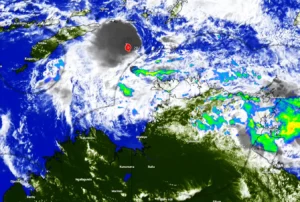Cold Front 37 Persists Over Yucatán, Keeping Ports Closed and Disrupting Coastal Life

A stubborn cold front, designated Cold Front 37, continues to grip Mexico's Yucatán Peninsula, forcing ports from Celestún to El Cuyo to remain closed for a third consecutive day. The system, which has unleashed strong northerly winds, high swells, and intermittent rain, has disrupted fishing, tourism, and daily activities along the coast since Monday, April 7. According to the National Oceanic and Atmospheric Administration (NOAA) and Mexico's National Meteorological Service (SMN), the front's effects are expected to gradually wane by Saturday, April 12, but not before delivering additional showers and challenging conditions to the region. Over the next two days, coastal communities should prepare for lingering impacts, while inland areas brace for scattered showers and cooler temperatures.
Ongoing Impacts of Cold Front 37
Cold Front 37, a sprawling system stretching across the eastern Yucatán Peninsula, has significantly altered weather patterns in the region. Since its arrival at noon on Monday, the front has brought sustained winds of 30–50 km/h (18–31 mph), with gusts reaching up to 60 km/h (37 mph) in exposed coastal areas. These conditions have generated high swells of 2–3 meters (6–10 feet), rendering navigation hazardous and prompting harbor masters to close ports to all maritime activity. The fishing industry, a cornerstone of the Yucatán's economy, has been hit particularly hard, with thousands of fishers unable to work for nearly a week.
Tourism, another vital sector, has also taken a hit. The iconic boardwalks of Progreso and other coastal towns have seen sparse crowds, as chilly temperatures and afternoon showers deter visitors. Temperatures in Mérida and coastal areas have dropped to 20–24°C (68–75°F), a noticeable departure from the region's typical April warmth. Schools have reported slight absenteeism, attributed to the inclement weather and cooler conditions, particularly in rural communities.
The front's influence extends beyond the coast. Inland areas of Yucatán, Campeche, and Quintana Roo have experienced intermittent showers, with rainfall totals of 25–50 mm (1–2 inches) recorded since Monday. In Chiapas, heavy rains of 50–75 mm (2–3 inches) have raised concerns about localized flooding, particularly in low-lying areas. The influx of tropical moisture, combined with the front's cold air mass, has also produced fog banks in higher-altitude regions of Oaxaca, Veracruz, and Tabasco, reducing visibility and complicating travel.

Two-Day Forecast: April 12–13, 2025
Over the next 48 hours, Cold Front 37 will continue to influence weather across the Yucatán Peninsula, though its intensity is expected to diminish. On Saturday, April 12, the front will remain stationary over the eastern peninsula, bringing scattered showers to Yucatán, Campeche, and Quintana Roo. Coastal areas can expect 10–25 mm (0.4–1 inch) of rain, primarily in the afternoon and evening, accompanied by breezy conditions with winds of 20–40 km/h (12–25 mph). Swells will gradually subside to 1–2 meters (3–6 feet), potentially allowing ports to reopen for smaller vessels by late Saturday, pending assessments by local authorities.
Inland, Mérida and surrounding areas will see partly cloudy skies with a 40% chance of showers, particularly in the early afternoon. Temperatures will hover between 22–27°C (72–81°F), with humidity levels remaining high due to lingering moisture. Chiapas will continue to experience heavier showers, with 25–50 mm (1–2 inches) possible in southern portions of the state. Oaxaca, Veracruz, and Tabasco may see lighter showers, with accumulations of 5–15 mm (0.2–0.6 inches).
By Sunday, April 13, the front will begin to move southeast toward the Caribbean Sea, marking the end of its direct influence on Mexico. The associated cold air mass will lose its thermal characteristics, allowing temperatures to climb back to 26–30°C (79–86°F) along the coast. Showers will become less frequent, with only isolated activity expected in Yucatán and Quintana Roo, totaling less than 10 mm (0.4 inches). Winds will weaken to 10–20 km/h (6–12 mph), and swells will drop below 1 meter (3 feet), signaling a return to safer maritime conditions. Ports are likely to fully reopen by Sunday morning, providing relief to fishers and businesses.
Broader Regional Effects
Cold Front 37's reach extends beyond the Yucatán Peninsula. In central Mexico, states like Michoacán, Hidalgo, Tlaxcala, and Puebla have experienced scattered showers and fog, particularly in mountainous areas. These conditions have disrupted agriculture and transportation, with farmers reporting delays in planting schedules due to wet soils. In Chiapas, the heaviest rainfall has prompted local authorities to monitor rivers and drainage systems for potential overflow, though no major flooding has been reported as of April 11.
The front's interaction with tropical moisture from the Gulf of Mexico and Caribbean Sea has amplified its effects, creating a complex weather pattern. NOAA's Global Forecast System (GFS) indicates that the system is being steered by a high-pressure ridge to the north, which has slowed its progression and prolonged its impacts. This setup is typical for late-season cold fronts, which often bring unseasonable weather to subtropical regions like the Yucatán.
Looking Ahead: A Return to Normalcy
As Cold Front 37 dissipates, the Yucatán Peninsula is expected to transition back to its characteristic warm and sunny weather by early next week. By Monday, April 14, high pressure will dominate, bringing clear skies and temperatures of 28–32°C (82–90°F). The fishing industry, which has faced significant losses, will likely resume full operations, while tourism is expected to rebound as visitors return to beaches and cultural sites.
However, the region remains vulnerable to additional weather systems. NOAA's Climate Prediction Center notes that neutral ENSO conditions in the Pacific could lead to an active late-season pattern, with more cold fronts possible through May. Residents and businesses are encouraged to stay informed and maintain preparedness measures, such as securing boats and reinforcing infrastructure, to mitigate future disruptions.
The SMN and NOAA urge residents to remain cautious over the next two days. Mariners should avoid unnecessary travel until ports are officially reopened, and coastal residents should secure outdoor items to prevent damage from lingering winds. Those in flood-prone areas of Chiapas and Campeche should monitor local alerts, as additional rainfall could exacerbate existing risks. Emergency kits with food, water, and medical supplies are recommended, particularly in rural areas where access to services may be limited.
As the region weathers the final effects of Cold Front 37, collaboration between local authorities, meteorologists, and communities will be key to minimizing impacts. The SMN will continue to provide updates through its website and regional broadcasts, ensuring residents have the information needed to stay safe.
Founder and chief forecaster of the Pogodnik service. He has many years of experience in the meteorological service. He is the author of numerous scientific publications and popular articles about the weather.




